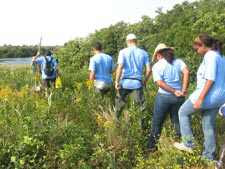NY1: Education NewsKlein To Meet With President About No Child Left Behind
 September 25, 2007
September 25, 2007  Schools Chancellor Joel Klein is scheduled to meet with President George W. Bush on Wednesday, right before the president delivers a speech about how Congress needs to renew his education law, No Child Left Behind.
Schools Chancellor Joel Klein is scheduled to meet with President George W. Bush on Wednesday, right before the president delivers a speech about how Congress needs to renew his education law, No Child Left Behind.
NY1 Education reporter Michael Meenan got some strong opinions around town on what Klein should say to the president about a law with so much impact on city classrooms."We need to take another look at how standardized tests are run," said parent Mike Piazza.
That is just one issue that parents say Joel Klein should tell the president on Wednesday about how to change the nation's education law, No Child Left Behind. It's about to expire this year and Congress is again debating how to achieve its big mission: make sure every American school kid is on equal par by 2014.
In order to accomplish that goal, African American and Latino kids need to be doing as well as white and Asian kids. The way Congress first thought it was fair to measure how that was happening, math and reading tests in third to eighth grade, is under fire.
"It's been a failure here in New York City," said Robert Jackson, chairman of the City Council’s education committee.
Jackson says Klein should tell Bush that No Child Left Behind has been a letdown. Jackson said standardized tests get way too much emphasis and the new law needs to allow for other assessments.
"We need flexibility so that children are evaluated on a more holistic basis and not just English, language arts, and math tests," said Jackson.
Klein declined an interview, but the Department of Education said the chancellor supports testing, but is open to other concrete ways to prove how students are doing, like grades and attendance. It's unclear if Bush would sign a law that allows for more than math and reading tests to show how children are doing in school.
There is also the issue as to how the law will paid for. Mayor Michael Bloomberg has said Washington undercuts the city on school funding. A spokesman for Congressman George Miller, chair of the House education committee, said that right now No Child is, "not fair enough, not flexible enough, not funded enough."
The spokesman said the law has been under-funded by $50 billion since 2002. Miller is said to be open to other options beyond math and reading tests.
"It's become a data-driven testing machine as opposed to, how do we get the resources for kids to learn?" said United Federation of Teachers President Randi Weingarten.
So, when Klein and Bush meet on Wednesday there will be a lot to talk about. The DOE says that testing and how much money the city gets from the federal government to help run the schools are two topics that will definitely be on the table.
- Michael Meenan
Schools Chancellor To Meet With President Bush
September 25, 2007While in town for the United Nations General Assembly, President Bush is planning on meeting with Schools Chancellor Joel Klein.
Tomorrow's meeting will give President Bush an opportunity to congratulate Klein following the news that the city school system won the prestigious Broad Prize for Urban Education, which is given to the country's most improved urban school system.
It will also give the president the chance to push his No Child Left Behind Act, which is up for reauthorization this year.
President Praises No Child Left Behind During City Visit
September 26, 2007President Bush called for Congress to renew his No Child Left Behind act Monday, as he wrapped up his trip to the city.
After meeting with Schools Chancellor Joel Klein, the president praised the mayor and chancellor's reforms of the city school system.
He said the No Child Left Behind reforms have led to improved test scores nationwide as well as helped to close achievement gaps across racial lines. And he said new national test scores are evidence his education initiative should be renewed.
"My call to the Congress is, ‘Don't water down this good law,’” said the president. “Don't go backwards when it comes to educational excellence. Don't roll back accountability. We've come too far to turn back.”
No Child Left Behind was first introduced in 2002, as a way to improve students' performances at primary and secondary schools. It is set to expire next year unless lawmakers reauthorize it. Critics say the act puts too much emphasis on math and reading test scores.
[where: 52 chambers street, new york ny 10007]















































